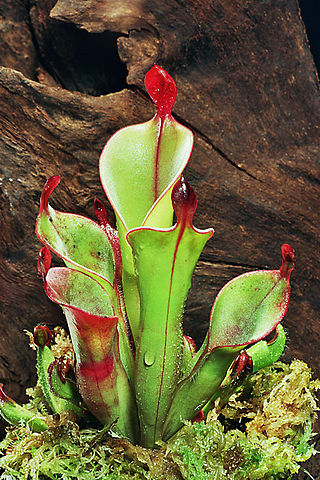
The genus Heliamphora contains 24 species of pitcher plants endemic to South America. The species are collectively known as sun pitchers, based on the mistaken notion that the heli of Heliamphora is from the Greek helios, meaning "sun". The name instead derives from the Greek helos, meaning "marsh", so a more accurate translation of their scientific name would be marsh pitcher plants. Species in the genus Heliamphora are carnivorous plants that consist of a modified leaf form that is fused into a tubular shape. They have evolved mechanisms to attract, trap, and kill insects; and control the amount of water in the pitcher. At least one species produces its own proteolytic enzymes that allows it to digest its prey without the help of symbiotic bacteria.

Andreas Wistuba is a German taxonomist and botanist specialising in the carnivorous plant genera Heliamphora and Nepenthes. More than half of all known Heliamphora species have been described by Wistuba.
Dr. Joachim Nerz is a German taxonomist and botanist specialising in the carnivorous plant genera Heliamphora and Nepenthes. Nerz has described several new species, mostly with Andreas Wistuba.

Heliamphora chimantensis is a species of marsh pitcher plant endemic to the Chimantá Massif in Venezuela. Specifically, it has been recorded from Apacará and Chimantá Tepuis. It is thought to be more closely related to the southern growing H. tatei and H. neblinae than to any of the other species found in the Gran Sabana and its tepuis. All other species known from this region have between 10 and 15 anthers, while H. tatei, H. neblinae and H. chimantensis have around 20. However, the anthers of H. tatei and the closely related H. neblinae are 7–9 mm long, while those of H. chimantensis only reach 5 mm in length.

Heliamphora folliculata is a species of Marsh Pitcher Plant endemic to the Aparaman group of tepuis in Venezuela. It grows on all four mountains: Aparaman Tepui, Murosipan Tepui, Tereke Tepui and Kamakeiwaran Tepui.
Heliamphora glabra is a species of marsh pitcher plant native to Serra do Sol in Venezuela. It was for a long time considered a form of H. heterodoxa, but has recently been raised to species rank.

Heliamphora heterodoxa is a species of marsh pitcher plant native to Venezuela and adjacent Guyana. It was first discovered in 1944 on the slopes interlinking Ptari-tepui and Sororopan-tepui and formally described in 1951.

Heliamphora hispida is a species of Marsh Pitcher Plant endemic to Cerro Neblina, the southernmost tepui of the Guiana Highlands at the Brazil-Venezuela border.

Heliamphora ionasi is a species of marsh pitcher plant thought to be endemic to the plateau that lies between the bases of Ilu Tepui and Tramen Tepui in Venezuela. It produces the largest pitchers in the genus, which can be up to 50 cm in height.

Heliamphora minor is a species of marsh pitcher plant endemic to Auyán-tepui in Venezuela. As the name suggests, it is one of the smallest species in the genus. It is closely related to H. ciliata and H. pulchella.
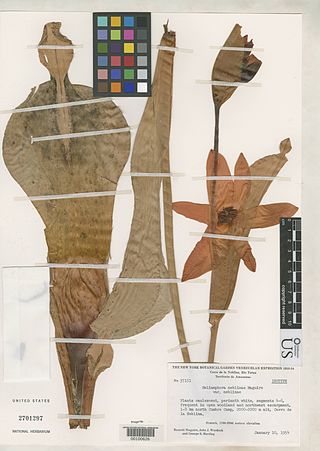
Heliamphora neblinae is a species of marsh pitcher plant endemic to Cerro de la Neblina, Cerro Aracamuni and Cerro Avispa in Venezuela. It is one of the most variable species in the genus and was once considered to be a variety of H. tatei. It is unclear whether or not there is a consensus regarding its status as a species, with at least a few researchers supporting the taxonomic revision that would elevate both H. tatei var. neblinae and H. tatei f. macdonaldae to full species status.

Heliamphora nutans is a species of marsh pitcher plant native to the border area between Venezuela, Brazil and Guyana, where it grows on several tepuis, including Roraima, Kukenán, Yuruaní, Maringma, and Wei Assipu. Heliamphora nutans was the first Heliamphora to be described and is the best known species.

Heliamphora pulchella is a species of marsh pitcher plant endemic to the Chimanta Massif and surrounding tepuis in Venezuela. It is one of the smallest species and closely related to H. minor.
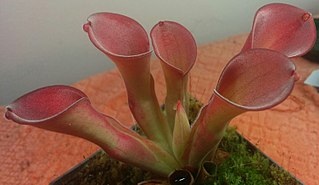
Heliamphora exappendiculata is a species of marsh pitcher plant native to the Chimantá and Aprada Massifs of Bolívar state, Venezuela. It was for a long time considered a variety of H. heterodoxa, but has recently been raised to species rank. Pitchers collect insects on flattened pitcher mouths which function as 'landing platforms' upon which prey falls from surrounding vegetation. Also, the pitcher shape effectively collects leaf litter and organic debris which may serve as additional source of nutrition for plants, similarly to H. ionasi.H. exappendiculata hybridizes naturally with H. pulchella and H. huberi in areas within which they grow together. This species occurs in shaded conditions, apparently preferring them over other habitats. In addition, plants upon Chimanta and Amuri Tepui grow directly upon the walls of gorges and ravines where surfaces are permanently wet. In contrast to those populations, on all other tepuis and massif regions the species grows on summit savannahs and stunted or shrubby forests, though these individuals represent a minority in habitat choice.
Heliamphora ciliata is a species of Marsh Pitcher Plant endemic to Venezuela. It is restricted to a small number of swampy meadows in the uplands of Gran Sabana. In this habitat it is sympatric with a species of Stegolepis (Rapateaceae). Unusually for the genus, H. ciliata is a submontane plant, growing at an elevation of only 900 m.
Heliamphora huberi is a species of Marsh Pitcher Plant endemic to the Chimantá Massif in Venezuela, where it grows at elevations of 1850–2200 m in a variety of habitats. It has thus far been recorded from Angasima-tepui, Apacará-tepui, Amurí-tepui, Acopán-tepui, and the border of Torono- and Chimantá-tepui. Due to its intermediate appearance between species related to H. minor and H. heterodoxa, it is suspected to be of hybridogenic origin.

Heliamphora purpurascens is a species of marsh pitcher plant known only from the summit area of Ptari Tepui in Venezuela, where it grows at elevations of 2400–2500 m.
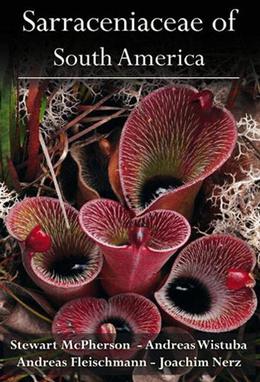
Sarraceniaceae of South America is a monograph on the pitcher plants of the genus Heliamphora by Stewart McPherson, Andreas Wistuba, Andreas Fleischmann, and Joachim Nerz. It was published in September 2011 by Redfern Natural History Productions and covered all species known at the time.
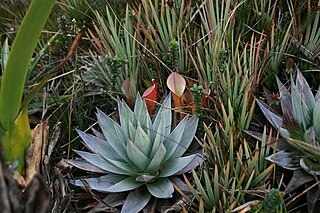
The natural range of the carnivorous plant genus Heliamphora is restricted to the southern Venezuelan states of Amazonas and Bolívar, and to adjacent portions of northern Brazil and western Guyana, an area corresponding to the western part of the Guayana Shield. These plants are largely confined to the summits and foothills of the sandstone table-top mountains of the region, known as tepuis.
Angasima-tepui, also known as Adanta, Adankasima or Adankachimö, is a tepui in Bolívar state, Venezuela. A relatively isolated peak, both it and nearby Upuigma-tepui lie just south of the vast Chimantá Massif, from which they are separated by the Río Aparurén valley. Amurí-tepui, the closest member of the Chimantá Massif, is only 8 kilometres (5.0 mi) from Angasima-tepui.













